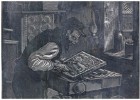The Internet Museum
of Prints is a unique project dedicated to prints. Its exhibits are works from the
private collection of Myasnoy Dom Borodona Company who initiated the idea of
creating this museum, and also some masterpieces from the Russia State Library
fund. A virtual museum in the Internet becomes a wonderful format for presenting
prints since in ‘real life‘ it is practically impossible to bring so many works of
art together in one space, let alone the technical challenge of creating the
necessary conditions for exhibiting prints.
Selection of the Russian
- Soviet school of engraving of the late 19th –early 20th
centuries as the first component of the virtual exhibition is not accidental.
That period was the time when engraving in general, and Russian and Soviet
engraving in particular, flourished. As is known, at the turn of the 19th
-20th centuries, engraving stopped performing a subservient role to
painting, prints stopped being used for reproduction purposes only and became
an art in its own right. So, it is this
art that our Internet Museum will be focusing on. The Museum’s main sections
are dedicated to its various techniques. Represented here are galleries of etching,
xylography, linoleum engraving and lithography. Each section contains a detailed
description of artistic and production features of these techniques reproducing
a lot of works by Russian and Soviet artists - Vasily Mathe, Vadim
Falileev, Anna Ostroumova-Lebedeva, Pavel Shillingovsky, Vasily Masiutin, Dmitry
Mitrokhin, Vladimir Favorsky, Nikolay Kupreyanov – and giving the viewer a
graphic idea of different types of engraving and its evolution.
On our website, you
will find short biographies of artists, a glossary of key terms and
bibliography. Comments to reproductions are made up of excerpts from studies by
scholars, letters and memoirs by artists, their colleagues and friends. The website
is meant for a wide range of users. It might be of interest to both, experts and
those who are not frequent guests to the world of fine arts. You could say it is
a kind of arts museum representing a lot of graphic material which is seldom exhibited
and also an additional source of information about prints and engravers. With the
help of the search engine, you will find the material you are interested in –
technique, genre, artist, or historical period. All this gives us ground to hope
that our “non-real” museum is capable
of really enriching the knowledge and
spiritual world of its visitors. That is
exactly what its goal is.

